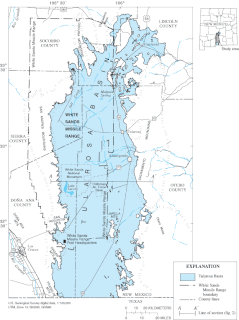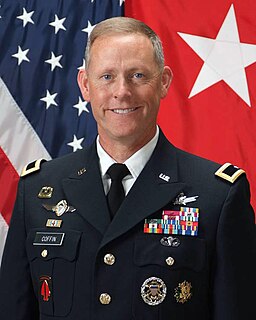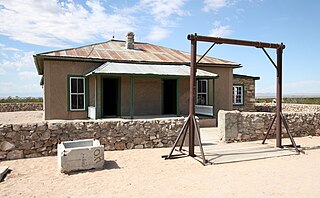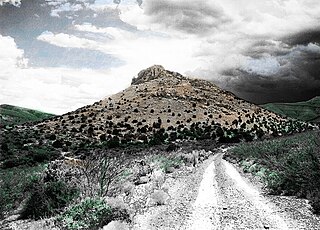 W
WWhite Sands Missile Range (WSMR) is a military testing area operated by the United States Army. The range was originally established as the White Sands Proving Ground on 9 July 1945. White Sands National Park is located within the range.
 W
WWhite Sands Missile Range (WSMR) is a military testing area operated by the United States Army. The range was originally established as the White Sands Proving Ground on 9 July 1945. White Sands National Park is located within the range.
 W
WTimothy R. Coffin is a United States Army brigadier general who became the 33rd Commanding General of the White Sands Missile Range on 2 July 2014.
 W
WUSS Desert Ship (LLS-1) is a concrete blockhouse providing assembly and launch facilities simulating shipboard conditions for Navy surface-to-air weapons testing at the Naval Air Warfare Center (NAWC) Weapons Division – White Sands.
 W
WNiles J. Fulwyler was a United States Army major general who served as Commanding General of the White Sands Missile Range from 1982 to 1986.
 W
WThe Utah Launch Complex was a Cold War military subinstallation of White Sands Missile Range for USAF and US Army rocket launches. In addition to firing Pershing missiles, the complex launched Athena RTV missiles with subscale (test) warheads of the Advanced Ballistic Re-entry System to reentry speeds and impact at the New Mexico range. From 1964 to 1975 there were 244 Green River launches, including 141 Athena launches and a Pershing to 281 kilometers altitude. "Utah State Route 19 runs through the Green River Launch Complex, which is south of the town and eponym of Green River."
 W
WProject Hermes was a missile research program ran by the Ordnance Corps of the United States Army from November 15, 1944 to December 31, 1954 in response to Germany's rocket attacks in Europe during the Second World War. The program was to determine the missile needs of army field forces. A research and development partnership between the Ordnance Corps and General Electric started November 20, 1944 and resulted in the "development of long-range missiles that could be used against both ground targets and high-altitude aircraft."
 W
WThe McDonald Ranch House, also known as Trinity Site, in the Oscura Mountains of Socorro County, New Mexico, was the location of assembly of the world's first nuclear weapon. The active components of the Trinity test "gadget", a plutonium Fat Man-type bomb similar to that later dropped on Nagasaki, Japan, were assembled there on July 13, 1945. The completed bomb was winched up the test tower the following day and detonated on July 16, 1945 as the Trinity nuclear test.
 W
WOscura Mountains, originally known to the Spanish as the Sierra Oscura, are a ridge of mountains, trending north and south, east of the Jornada del Muerto and west of the Tularosa Valley. It is located in Socorro County and Lincoln County, New Mexico. Their highest elevation is Oscura Peak at 8,625 feet / 2,629 meters. Its southern end is at 33°30′30″N 106°18′45″W and its north end is at 33°49′15″N 106°22′20″W near North Oscura Peak.
 W
WJohn G. Shinkle was a United States Army general who became the first commander of the Army Rocket and Guided Missile Agency and the sixth commander of the White Sands Missile Range.
 W
WGerman V-2 rockets captured by the United States Army at the end of World War II were used as sounding rockets to carry scientific instruments into the earth's upper atmosphere at White Sands Missile Range (WSMR) for a program of atmospheric and solar investigation through the late 1940s. Rocket trajectory was intended to carry the rocket about 100 miles (160 km) high and 30 miles (48 km) horizontally from WSMR Launch Complex 33. Impact velocity of returning rockets was reduced by inducing structural failure of the rocket airframe upon atmospheric re-entry. More durable recordings and instruments might be recovered from the rockets after ground impact, but telemetry was developed to transmit and record instrument readings during flight.
 W
WThe list of V-2 test launches identifies World War II launches of the A4 rocket. Test launches were made at Peenemünde Test Stand VII, Blizna and Tuchola Forest using experimental and production rockets fabricated at Peenemünde and at the Mittelwerk. Post-war launches were conducted at Cuxhaven, White Sands Proving Grounds, Cape Canaveral, Kapustin Yar, and on the USS Midway during Operation Sandy.
 W
WVictorio Peak is a high rocky outcropping in the Hembrillo Basin in southern New Mexico. This was one of Chief Victorio's hideouts, and was the site of a battle in 1880 between Victorio's Apaches and the U.S. Army Ninth Cavalry "Buffalo Soldiers." Additionally, gold prospector Milton "Doc" Noss claimed to have found hidden treasure inside the Mountains in the late 1930s.
 W
WWhite Sands Missile Range (WSMR) is a military testing area operated by the United States Army. The range was originally established as the White Sands Proving Ground on 9 July 1945. White Sands National Park is located within the range.
 W
WLaunch Complex 38 was the White Sands Missile Range facility for testing the Nike Zeus anti-ballistic missile. The site is located east of the WSMR Post Area.
 W
WWhite Sands Space Harbor (WSSH) is a spaceport that was formerly used as a Space Shuttle runway, a test site for rocket research, and the primary training area used by NASA for Space Shuttle pilots practicing approaches and landings in the Shuttle Training Aircraft and T-38 Talon aircraft. With its runways, navigational aids, runway lighting, and control facilities, it also served as a backup Shuttle landing site. WSSH is a part of the White Sands Test Facility, and is located approximately 30 miles west of Alamogordo, New Mexico, within the boundaries of the White Sands Missile Range.
 W
WThe White Sands V-2 Launching Site, also known as Launch Complex 33 and originally as Army Launch Area Number 1, is an historic rocket launch complex at White Sands Missile Range in southern New Mexico. It was here that the United States first performed test launches of German V-2 rockets captured toward the end of World War II. These tests were the first step in both military advances in rocketry, and in the development of the United States space exploration programs. The site was designated a National Historic Landmark in 1985.